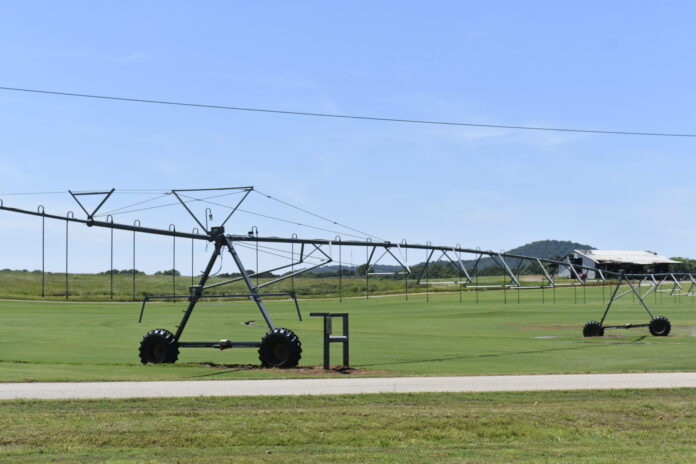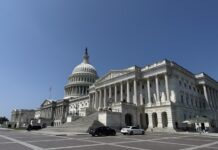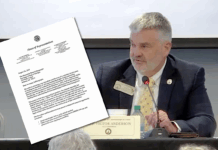
WASHINGTON (States Newsroom) — Farmers across the United States are finding themselves in precarious economic positions, as they attempt to navigate a strained farm economy and a barrage of executive orders from the Trump administration that put some farm programs in limbo.
In his first month in office, President Donald Trump has issued a flurry of executive orders to pause or cancel federal funding on a range of programs and grants — some of which go directly to farmers.
Even though the administration said it would not stop payments to individuals and courts have ordered the administration to resume the programs, many farmers are awaiting payments on their contracts and have not been told when or if they can expect to receive expected funding. Billions of dollars are at stake.
Missouri cattle producer Skylar Holden signed a $240,000 cost-sharing contract with the U.S. Department of Agriculture to improve water systems on his 260-acre cattle operation. After getting approval in January for the next phase of the project and investing upwards of $50,000 in pipes, equipment and labor, Holden says he got a call a week later from his field agent telling him the payments from USDA were on hold.
“I instantly asked … what does that mean for all this money that I just spent, that I’m relying on these funds to come through?” Holden recounted in a TikTok live on Feb. 13.
He said he was told the money was frozen and that it was not clear when or if the payments would happen.
“Then to be honest with you, I just kind of zoned out. I just started running numbers in my head … I was trying to figure out how I could make this work,” Holden said.
He already works another job to try to make ends meet on the farm and cares for his cattle after work. He says the debt on this project could mean disaster for his farm.
When asked on a scale of 1 to 10 what his confidence was that the payment would come through eventually, Holden, who voted for Trump, rated the possibility a “one.”
“I guess I have maybe a little bit of hope I will see the funding, but I am not too confident,” Holden said in the TikTok live.
‘Farmers are left wondering’
Representatives from farm advocacy groups and cooperatives say they are hearing similar stories from their members, but most are unwilling to speak publicly for fear of retribution. Many large farm organizations backed Trump’s successful presidential campaign.
“We continue to hear from family farmers and ranchers about the federal funding freeze, which has created significant uncertainty,” said Rob Larew, president of the National Farmers Union, an advocacy group that represents 220,000 farmers and ranchers in 33 states. “The interruption in funding raises concerns about whether USDA will disburse already obligated funds to farmers who have existing agreements with the department.”
“The lack of clarity is leaving state and local agencies and partner organizations struggling to interpret and implement federal programs, while farmers are left wondering if they can rely on these programs as they make critical business decisions for the year ahead,” Larew said.
The financial implications are huge in the administration’s efforts to freeze or cancel funding. One of Trump’s first executive orders called for a pause on all funding from the Inflation Reduction Act, enacted by Democrats during the Biden administration, which provided nearly $20 billion for farmland conservation programs.
Another directive briefly paused all federal financial assistance. Other executive orders put a freeze on all foreign aid and dismantled the U.S. Agency for International Development, significant for American farmers because it purchases grains and goods for food programs and funds some agricultural research projects.
In limbo in Colorado
Roy Pfaltzgraff is trying to navigate the uncertainty on his 2,000-acre gluten-free grain farm in northeast Colorado.
He is struggling to get the farm refinanced, and a recent lender told him they would not calculate government payments — long considered a reliable backup for farmers — as part of his income, even if he has ongoing contracts. His federal contracts have not been canceled, as far as he knows, but he is afraid to spend money on them or pursue new projects.
“My concern is that if we get started and spend a bunch of money with the expectation that we will get some of it paid back, what if we don’t? There are limits on what we can do,” Pfaltzgraff said in an interview.
Pfaltzgraff is also concerned how the pause on USAID programs could affect his farm and others, potentially causing a domino effect on crop prices.
USAID is one of the biggest purchasers of sorghum and other excess grains. Without their purchases, those grains could flood the market and drive down prices.
More than 450 producers around the country have contracts with USAID, according to an analysis by the Institute for Development Impact, and the agency’s purchases at grain elevators benefit many more.
Food for Peace, one of USAID’s programs, provided nearly 4 billion pounds of American-grown food to 58 million people globally in 2022, according to the U.N. World Food Programme.
Interruption in research
The abrupt pause for USAID programs also interrupts agricultural research programs at 19 land-grant university-based innovation labs across 17 states — casting an uncertain future for those projects and the foreign grain markets they are attempting to cultivate.
The Soybean Innovation Lab at the University of Illinois announced last week it will close in April. The closure will have an immediate effect on the staff of 30 experts in tropical soybean and longer-term repercussions on their work to develop an emerging market for soybeans in Africa.
The lab’s director, University of Illinois Professor Peter Goldsmith, said he had to make the hard decision to shutter the lab when they were suddenly no longer able to access any of their grant money or reimbursement systems. They are in the middle of work on a $30 million USAID grant that was supposed to last until 2027.
“Where does the money come from to pay salaries, to pay people, to water the plants, I mean everything?” Goldsmith said in an interview. “We’ve run a very tight budget, but I never put into the scenario an act of God like this.”
When Elon Musk’s U.S. DOGE Service, known as the Department of Government Efficiency, dismantled USAID, it took down the agency’s website and its procurement and payment systems — shutting down the ability for anyone with a contract to be paid for past or future work.
‘A level of uncertainty that is unique to the moment’
For farmers, this comes at a time when they are already facing economic strain. Falling prices for corn, soybean and wheat over the last two years have led to declines in net farm income.
Jonathan Coppess, an agriculture economist at the University of Illinois, said farmers are facing compounding economic challenges: the underlying economic strain of volatile prices, high costs and inflationary pressures are being magnified by the uncharacteristic uncertainty about contracts, tariffs and trade.
“It’s a level of uncertainty that is very unique to the moment,” Coppess said in an interview. “Dealing with costs and crop prices is a common thing. Dealing with broken contracts, tariffs and possible retaliatory trade issues, those are not common things. There’s almost two layers to the challenge.”
Adding to that uncertainty, Congress is two years late reauthorizing the farm bill. And lawmakers on the House Budget Committee have called for billions of dollars in cuts to farm bill spending over the next 10 years.
Alisha Schwertner, a farmer and rancher in Miles, Texas, told the House Agriculture Committee at a hearing on Feb. 11 that weather disasters, inflation and supply chain disruptions have put a strain on her family operation.
Schwertner said the economic uncertainty has made it difficult for her to get credit for the farm and she fears what retaliatory tariffs could do to their bottom line.
“My husband and I have had some very challenging conversations with our banker, especially in the last three years, as we have had consecutively challenging years,” Schwertner told the committee.
When Trump levied tariffs on steel and aluminum in 2018, trading partners retaliated with their own tariffs on soybeans and other U.S. agriculture exports, leading to a decline in some exports and prices paid to U.S. farmers. USDA gave $28 billion in emergency aid to farmers the following year.
A target on conservation programs
Among the Trump administration’s targets are conservation programs funded by the Inflation Reduction Act, one of former President Joe Biden’s signature achievements. The Trump administration has characterized IRA as “green new deal social engineering policies.”
Among the many environmental programs IRA funded across the federal government was $19.5 billion for farmland conservation programs at USDA.
Trump signed an executive order to freeze all IRA programs on his first day in office. A federal judge ordered the administration on Feb. 10 to unfreeze the funds, but farmers and conservation consultants say they have not yet seen changes.
When asked which programs are frozen and if they would release money in response to the order, a spokesperson for the Agriculture Department said the agency would respond after Brooke Rollins had a chance to analyze reviews. The Senate confirmed Rollins as Agriculture Secretary on Feb. 13.
“The Trump Administration rightfully has asked for a comprehensive review of all contracts, work, and personnel across all federal agencies. Anything that violates the President’s Executive Orders will be subject for review,” the USDA spokesperson said.
In Rollins’ first full day at the agency, Feb. 14, she announced the termination of 78 contracts worth $138 million and said she is reviewing 1,000 more to look for opportunities to stop “wasteful spending” that does not align with administration priorities.
The canceled programs the agency announced were not direct payments to farmers, but included climate change adaptation research, forest carbon mentorship and subscriptions to news outlets.
Republicans have decried the partisan way Democrats pushed through the IRA bill. But much of its agriculture funding went to longstanding farm bill programs that previously gained bipartisan support.
It increased investments for the chronically oversubscribed Environmental Quality Incentives Program and Conservation Stewardship Program. In recent years, those programs were only able to fund about 30 percent of applications, according to an analysis of government data by the Environmental Working Group.
“The IRA funding for USDA conservation programs allowed a lot of farmers and ranchers to access conservation funding who weren’t able to before, but now halfway through, their payments are frozen, and it is unclear what will happen next,” said Aviva Glaser, senior director of agriculture policy for the National Wildlife Federation.
If the funds remain frozen, it could affect thousands of contracts nationwide. The Natural Resources Conservation Service, the branch of USDA that oversees most conservation programs, has 4,162 contracts obligated in 2025 for $358 million.
In many cases, farmers have already taken on the financial burden. USDA agrees to cost-share practices like planting trees or native plants, protecting a stream from cattle or installing solar panels or other energy-efficient systems.
The landowner pays for the improvements and then submits documentation for the government to pay out its cost-share. So for Holden, the Missouri cattle producer, and other producers awaiting payment, they are already shouldering tens of thousands of dollars of debt for the programs.
The IRA pause is also creating some confusion, since it funds many of the same practices and programs that are also funded by the farm bill. Farmers sign contracts to commit to certain practices but may not know what underlying legislation funded the program, so they don’t know if their contract might be on the hit list.
“There is a lot of confusion and uncertainty about USDA funding and farmers are feeling it. The longer this funding freeze is in place, the more uncertainty and panic will grow amongst producers,” Glaser said.






